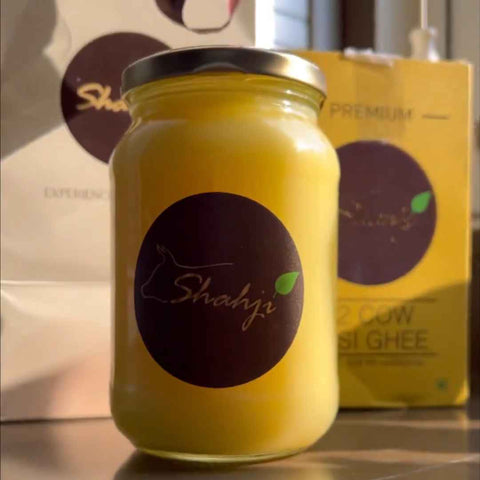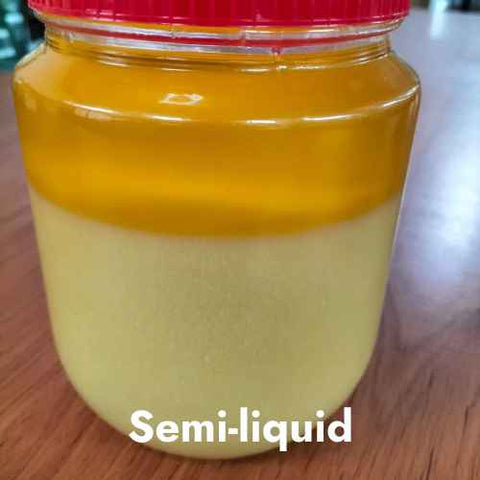13+ Best High-Quality Desi Ghee Brands In India [2025]

Desi cow ghee is not only a popular culinary ingredient but also a significant constituent of many ayurvedic medicines. It is supposed to be light yellow in color, transparent appearance, granular texture, and nutty flavor. The physical properties of the ghee depend on different factors, such as the source of milk, season, climate, temperatures, processing techniques, and the cow\’s diet.
Why ghee has different colour & texture? and What is the texture of pure Ghee?
What is the texture of pure Ghee?
Normally, Fresh Ghee has liquid state at normal room temperature. When temperature slightly fall up or down, ghee texture will changes to semi-liquid and solid.
What Is The Pure Ghee Color?
Cow desi ghee is bright yellow because of beta carotene. This carotenoid pigment comes from the cows’ diet, which consists primarily of dried grass, grass, grains, and cereals. The amount of beta carotene in cow ghee depends on feed, breed, season, and lactation period.
While cow ghee is yellow, buffalo ghee is white (with a greenish tinge sometimes as per region and feeding schedule). Mixed milk-ghee has a straw-yellow color. The color of the melted ghee is darker than when it is in solid form.
What Is The Process Of Making Pure Ghee?

To make ghee, milk is taken from the desi cow. Then the milk is boiled and allowed to cool. After that, the milk with cream (which has risen to the top) is cultured with curd. It is allowed to sit for four to five hours, after which the curdled whole milk is churned back and forth using bilona.
According to Ayurveda, ghee made without traditional culturing and churning lacks the appropriate Agni. The butter obtained from churning is heated in an earthen pot and brought to a boil. The flame is then reduced, and the butter continues to boil. When moisture evaporates, the butter will turn from cloudy yellow color to golden.
The time of the best ghee formation is crucial. If the ghee is not cooked through properly, some moisture remains in it. The ghee will tend to go sour. If ghee is simmered too much past the correct point, it will get a burnt nutty taste and be slightly darker. The ‘perfect’ ghee lies between these two ‘extremes’.
Factors Affecting Ghee Texture and Color
Pure Ghee Texture & Color in Different Conditions and science behind this
- Diet
- Seasons
- Temperature
1. Diet: How cow\’s diet affects ghee texture?
The quality of ghee will change as the cow\’s diet changes. Many cows do not have green fields to graze on. Many dairy farmers feel that an overdose of grass in the diet lends a grassy taste to the milk. So they give hay, silage, or legumes.
In the seasons when the cows don\’t get grass (the regions where cows don\’t have access to grass), there is more hay and legumes in their diet. Many dairy producers also include steroids and growth hormones. These affect the quality of milk, butter, and ghee.
Grass-fed Cow Ghee Color
The ghee of grass-fed cows is more yellow due to more beta-carotene in the butter. It is also sweeter and had more nutrients than ghee from grain-fed or hay-fed cows. Shahji Ghee makes bilona ghee only from grass-fed cows and that is why you get the most delicious ghee in India.
2. Temperature: How temperature affects ghee texture?
1. Grainy Ghee Texture
How ghee become granny?

If the newly made ghee is cooled slowly, it constitute a grainy texture. So, instead of refrigerating if you place it on your kitchen countertop, cover it with a cloth, and allow it to cool slowly – the ghee will get a grainy look. The texture is due to the variety of fatty acids present in ghee.
2. Liquid Ghee Texture
How ghee become Liquid?

When ghee is stored at normal room temperature, then you can find ghee in liquid form. Ghee is consistent liquid at room temperature, if temperature is slightly changed then ghee become semi-liquid. Change in any texture of does not effect quality and nutrition of ghee.
3. Creamy Ghee Texture
How ghee become creamy?
After ghee is made, if it is cooled rapidly, it gets a solid creamy look. If you want to try it for yourself, you may refrigerate (but not freeze) the newly made ghee overnight. This cools it quickly. The next day, take it out and leave it on your kitchen countertop. Depending on the room temperature, the final texture of the ghee will be solid or creamy.
4. Semi-liquid Ghee Texture
How ghee become semi-liquid?
In mass production when ghee jars are being filled, the jars at the edges have a more solid texture. Those in the centre are more liquid. The difference in texture results due to temperature. The taste, quality, and shelf-life are the same irrespective of the textures.
3. Season: How different seasons affects ghee texture?
The season is a vital factor affecting ghee texture and color. India has four seasons, and any weather change affects ghee. This is because weather influences land, grass, and even the mood of the animal. This has an impact on milk and ghee.
Generally, ghee is the yellowest after monsoons(probably because of the availability of lush green grass), and the color begins to lighten as summers come. The ghee remains liquid during summer and becomes creamy in winter.
Why Ghee Has Different Texture Like Granular, Liquid, Semi-Liquid, And Solid?
Sometime you see ghee has 4 different texture – Liquid, Solid, Creamy & Semi-Liquid. The inconsistent storage temperature causes the texture to be changed. It is crucial to note that ghee might have any texture but it has No effect on the quality of the Ghee.

Why Ghee Is Not Melting in Jar During Summer Season? Is It Pure Or Not?
We pack fresh & pure ghee and when it reaches to the customer and you found that ghee is not melted in jar in that heat of summer season. Well, it does not mean ghee is not pure because it is fully seal packed and if you want to check the purity of ghee, you have to put ghee on your palm and if it start melting that means this ghee is pure.
Why Ghee Is Not Become Solid In Winter?
When we manufacture ghee, we leave it in 30-40 litre pots to cool slowly. Granules might enter ghee due to slow cooling. The slow cooling procedure is critical for freezing the ghee. The texture of ghee does not guarantee purity or impurities. If we only prepare 1 or 5 litres of ghee in a pot, it will solidify in 12 hours if the temperature drops below 5 degrees Celsius in the winter.
Why My Ghee is Liquid With Less Granular? Is It Pure?
Purity cannot be calculated using granules. As previously stated, transit duration and weather have an important impact in granule reduction. Granules can be seen in Dalda ghee. What important is the total effect of ghee on your body.
Why My Ghee is Half Solid & Half Liquid? Is It Pure?
Ghee is made up of Granules, which are heavier than liquid Ghee. The particles at the bottom will disappear as the ghee sits and settles over time. It\’s a very normal process.
Why Liquid Ghee Turned Into Solid Ghee, Over Time?
Ghee\’s condition varies fairly quickly over night depending on the temperature of the environment. When the ghee was made, the production period and travel weather must have been longer. However, when it is at your room temperature, it will alter its state when the temperature drops. It\’s quite natural.
Why Ghee has 2 Shades, Light Yellow & Yellow in Same Jar?
Granules are found in ghee. When they settle in the bottom, they begin to harden over time. The solid or semi-solid parts of ghee will always be light in hue due to the tendency of the pigment to compress inside. You may mix the ghee with a spoon or heat it slightly to see a golden tint all around.
Conclusion
We see that the ghee of grass-fed cows is yellower and sweeter. The texture of ghee can be smooth or grainy depending on how it is cooled. It is absolutely common for ghee to be liquid, solid, or a mixture of the two. All of these are affected by the temperature outside the jar.



















